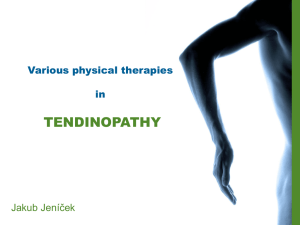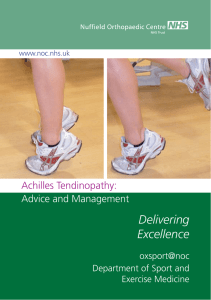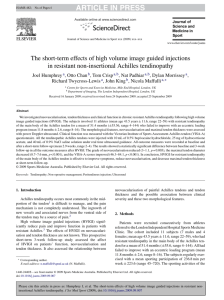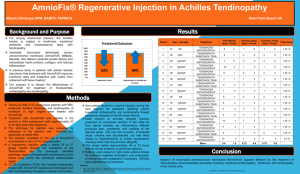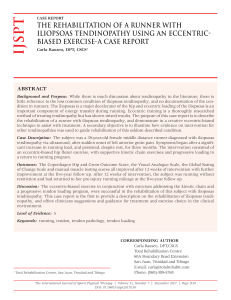Lower Extremity Tendinopathies: From Mechanisms to Treatment
advertisement
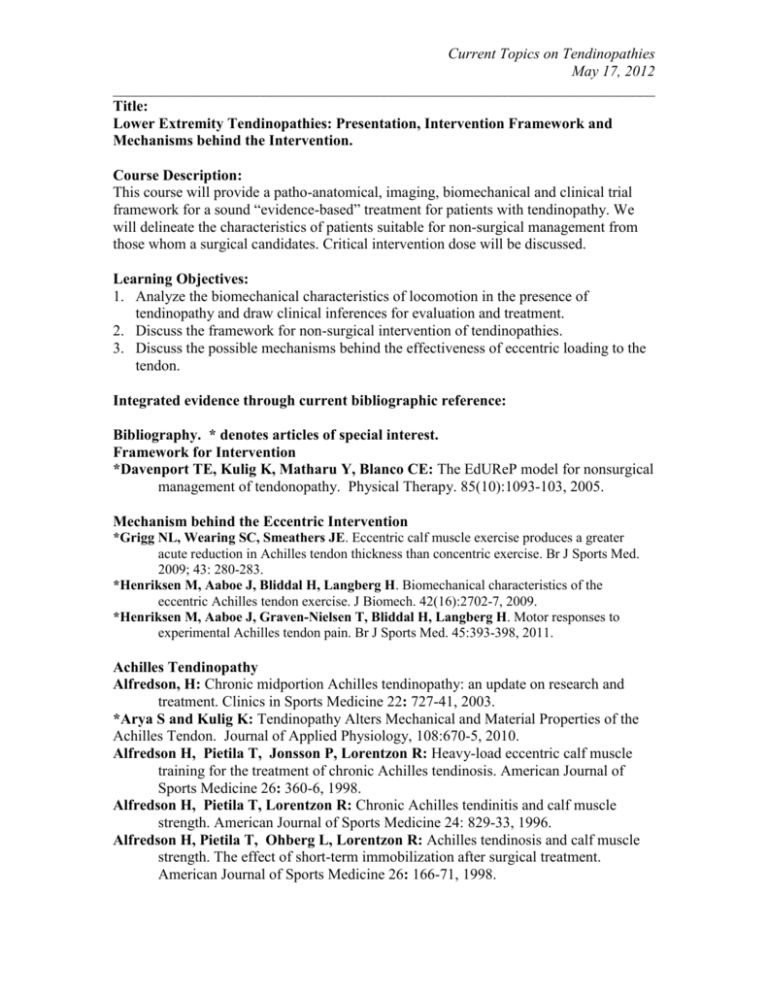
Current Topics on Tendinopathies May 17, 2012 ________________________________________________________________________ Title: Lower Extremity Tendinopathies: Presentation, Intervention Framework and Mechanisms behind the Intervention. Course Description: This course will provide a patho-anatomical, imaging, biomechanical and clinical trial framework for a sound “evidence-based” treatment for patients with tendinopathy. We will delineate the characteristics of patients suitable for non-surgical management from those whom a surgical candidates. Critical intervention dose will be discussed. Learning Objectives: 1. Analyze the biomechanical characteristics of locomotion in the presence of tendinopathy and draw clinical inferences for evaluation and treatment. 2. Discuss the framework for non-surgical intervention of tendinopathies. 3. Discuss the possible mechanisms behind the effectiveness of eccentric loading to the tendon. Integrated evidence through current bibliographic reference: Bibliography. * denotes articles of special interest. Framework for Intervention *Davenport TE, Kulig K, Matharu Y, Blanco CE: The EdUReP model for nonsurgical management of tendonopathy. Physical Therapy. 85(10):1093-103, 2005. Mechanism behind the Eccentric Intervention *Grigg NL, Wearing SC, Smeathers JE. Eccentric calf muscle exercise produces a greater acute reduction in Achilles tendon thickness than concentric exercise. Br J Sports Med. 2009; 43: 280-283. *Henriksen M, Aaboe J, Bliddal H, Langberg H. Biomechanical characteristics of the eccentric Achilles tendon exercise. J Biomech. 42(16):2702-7, 2009. *Henriksen M, Aaboe J, Graven-Nielsen T, Bliddal H, Langberg H. Motor responses to experimental Achilles tendon pain. Br J Sports Med. 45:393-398, 2011. Achilles Tendinopathy Alfredson, H: Chronic midportion Achilles tendinopathy: an update on research and treatment. Clinics in Sports Medicine 22: 727-41, 2003. *Arya S and Kulig K: Tendinopathy Alters Mechanical and Material Properties of the Achilles Tendon. Journal of Applied Physiology, 108:670-5, 2010. Alfredson H, Pietila T, Jonsson P, Lorentzon R: Heavy-load eccentric calf muscle training for the treatment of chronic Achilles tendinosis. American Journal of Sports Medicine 26: 360-6, 1998. Alfredson H, Pietila T, Lorentzon R: Chronic Achilles tendinitis and calf muscle strength. American Journal of Sports Medicine 24: 829-33, 1996. Alfredson H, Pietila T, Ohberg L, Lorentzon R: Achilles tendinosis and calf muscle strength. The effect of short-term immobilization after surgical treatment. American Journal of Sports Medicine 26: 166-71, 1998. Current Topics on Tendinopathies May 17, 2012 ________________________________________________________________________ *Baur H, Müller S, Hirschmüller A, Cassel M, Weber J, Mayer F.Comparison in lower leg neuromuscular activity between runners with unilateral mid-portion Achilles tendinopathy and healthy individuals. J Electromyogr Kinesiol;21(3):499-505, 2011. *Kulig K, Loudon JK, Popovich JM Jr., Pollard CD, Winder BR: Dancers with Achilles tendinopathy demonstrate altered lower extremity take-off kinematics. Journal of Orthopedic and Sports Physical Therapy, 41:606-613, 2011. Ohberg L, Alfredson H: Effects on neovascularisation behind the good results with eccentric training in chronic mid-portion Achilles tendinosis? Knee Surgery, Sports Traumatology, Arthroscopy 12: 465-70, 2004. Ohberg L, Lorentzon R, Alfredson, H: Eccentric training in patients with chronic Achilles tendinosis: normalised tendon structure and decreased thickness at follow up. BJSM online 38(5):597-600 38: 8-11; discussion 11, 2004. Ohberg L, Lorentzon R, Alfredson H: Good clinical results but persisting side-to-side differences in calf muscle strength after surgical treatment of chronic Achilles tendinosis: a 5-year follow-up. Scand J Med Sci Sports 9(2):104-9 11: 207-12, 2001. Williams DS, Zambardino JA, Banning VA. Transverse-plane mechanics at the knee and tibia in runners with and without a history of achilles tendonopathy. J Orthop Sports Phys Ther.38(12):761-7, 2008. Posterior Tibial Tendinopathy Alvarez RG, Marini A, Schmitt C, Saltzman CL: Stage I and II Posterior Tibial Tendon Dysfunction Treated by a Structured Nonoperative Management Protocol: An Orthosis and Exercise Program. Foot Ankle Int 22(3):214-9 27: 2-8, 2006. Augustin JF, Lin SS, Berberian WS, Johnson JE: Nonoperative treatment of adult acquired flat foot with the Arizona brace. Foot Ankle Clin 6(1):129-35, vii 8: 491-502, 2003. Flemister S, Neville C, Houck, JR: The Relationship among Ankle, Hindfoot and Forefoot Position and Posterior Tibialis Muscle Length. Foot and Ankle International, Foot Ankle Int. 28(4):448-55, 2007. *Kulig K, Popovich JM Jr., Nocetti-DeWit L, Reischl SF, Kim D: Persons with Posterior Tibial Tendon Dysfunction have Diminished Hip Muscle Performance. Journal of Orthopedic and Sports Physical Therapy, 41:687-694, 2011. Kulig K, Lederhaus E, Reischl SF, Arya S, Bashford GB: Does a 10-week tendon specific eccentric exercise program alter the degenerated tibialis posterior tendon? Foot and Ankle International 30:877-85, 2009. Kulig K, Reischl SF, Pomrantz AB, Burnfield JM, Mais-Requejo S, Thordarson DB, Smith RW: Non-operative management of tibialis posterior tendon dysfunction using orthoses and resistive exercise: a randomized clinical trial. Physical Therapy, 89:26-36, 2009. Kulig K, Pomrantz AB, Burnfield JM, Reischl SF, Mais-Requejo S, Thordarson DB, Smith RW: Non-operative management of posterior tibialis tendon dysfunction: design of a randomized clinical trial BMC Musculoskeletal Disorders. 7:49, 2006. Current Topics on Tendinopathies May 17, 2012 ________________________________________________________________________ Kulig K, Burnfield JM, Reischl S, Requejo SM. Blanco CE. Thordarson DB. Effect of foot orthoses on tibialis posterior activation in persons with pes planus. Medicine & Science in Sports & Exercise. 37:24-9, 2005. Kulig K, Burnfield JM, Requejo SM, Sperry M, Terk M: Selective activation of tibialis posterior: evaluation by magnetic resonance imaging. Med Sci Sports Exerc 36: 862-7, 2004. Neville CG, Flemister AS, Tome, J, Houck J: Comparison of Changes in Posterior Tibialis Muscle Length Between Subjects with Posterior Tibial Tendon Dysfunction and Healthy Controls. J Orthop Sports Phys Ther. 37(11):661-9. 2007. Tome J, Flemister S, Nawoczenski D, Houck J: Comparison of Foot Kinematics between Subjects with Posterior Tibial Tendon Dysfunction and Healthy Controls. Journal of Orthopedic & Sports Physical Therapy 36: 635-644, 2006. Patellar Tendinopathy Visnes H, Bahr R: The evolution of eccentric training as treatment for patellar tendinopathy (jumper's knee) - a critical review of exercise programs. Br J Sports Med. 2007 Jan 29; Bahr R, Fossan B, Loken S, Engebretsen L: Surgical treatment compared with eccentric training for patellar tendinopathy (Jumper's Knee). A randomized, controlled trial. J Bone Joint Surg Am. 88(8):1689-98, 2006. Hoksrud A, Ohberg L, Alfredson H, Bahr R: Ultrasound-guided sclerosis of neovessels in painful chronic patellar tendinopathy: a randomized controlled trial. Am J Sports Med. 2006 34(11):1738-46, 2006. Lian O, Dahl J, Ackermann PW, Frihagen F, Engebretsen L, Bahr R: Proprioceptive and antinociceptive neuromediators in patellar tendinopathy. Am J Sports Med. 34(11):1801-8, 2006. Sorenson SC, Arya S, Souza RB, Pollard CD, Salem GJ, Kulig K. Knee Extensor Dynamics in the Volleyball Approach Jump: The Influence of Patellar Tendinopathy. Journal of Orthopedic and Sports Physical Therapy, 40:568-576, 2010. Current Topics on Tendinopathies May 17, 2012 ________________________________________________________________________ Session outline (topic and duration) Topic Time Time (minutes) Mechanical properties of tendons and their relevance to degeneration and potential for healing. 3:00-3:15 p.m. 45 Biomechanical characteristics of locomotion (running, jumping, leaping), in the presence of tendinopathy and clinical inferences for evaluation and treatment. 3:15-4:00 p.m. 45 BREAK Proposed mechanisms behind eccentric re-loading. 4:00-4:15 p.m. 4:15-4:35 p.m. 15 20 Common and tendon specific ingredients of effective interventions for the tendons of Achilles, Patellar and Tibialis Posterior. 4:35-5:45 p.m. 70 Discussion, Questions and Answers 5:45-6:00 p.m 15 Current Topics on Tendinopathies May 17, 2012 ________________________________________________________________________ Kornelia Kulig, PhD, PT, FAPTA, FMAAOMPT is a Professor of Biokinesiology and Orthopedic Surgery and a Co-Director of the Musculoskeletal Biomechanics Research Laboratory at the University of Southern California. Her research explores tissue morphology, biomechanics, physiology, and pathology in relation to degenerative processes in connective tissues and accompanying muscle activation, kinematic and kinetic movement strategies and related signs, symptoms, and loss of function. Dr. Kulig is a member of the American Physical Therapy Association, American College of Sports Medicine and the American and International Societies of Biomechanics. Dr. Kulig serves as a reviewer for several biomechanical and clinical journals and servers as an Editorial Board Member of the Journal of Orthopaedic and Sports Physical Therapy and Physiotherapy. She is a Founding Member of the American Academy of Orthopedic Manual Physical Therapists. Keywords: Tendinopathy, metabolic syndrome, extremities Teaching and Learning Strategies: Lecture and discussion Instructional Level: Intermediate to Advanced

